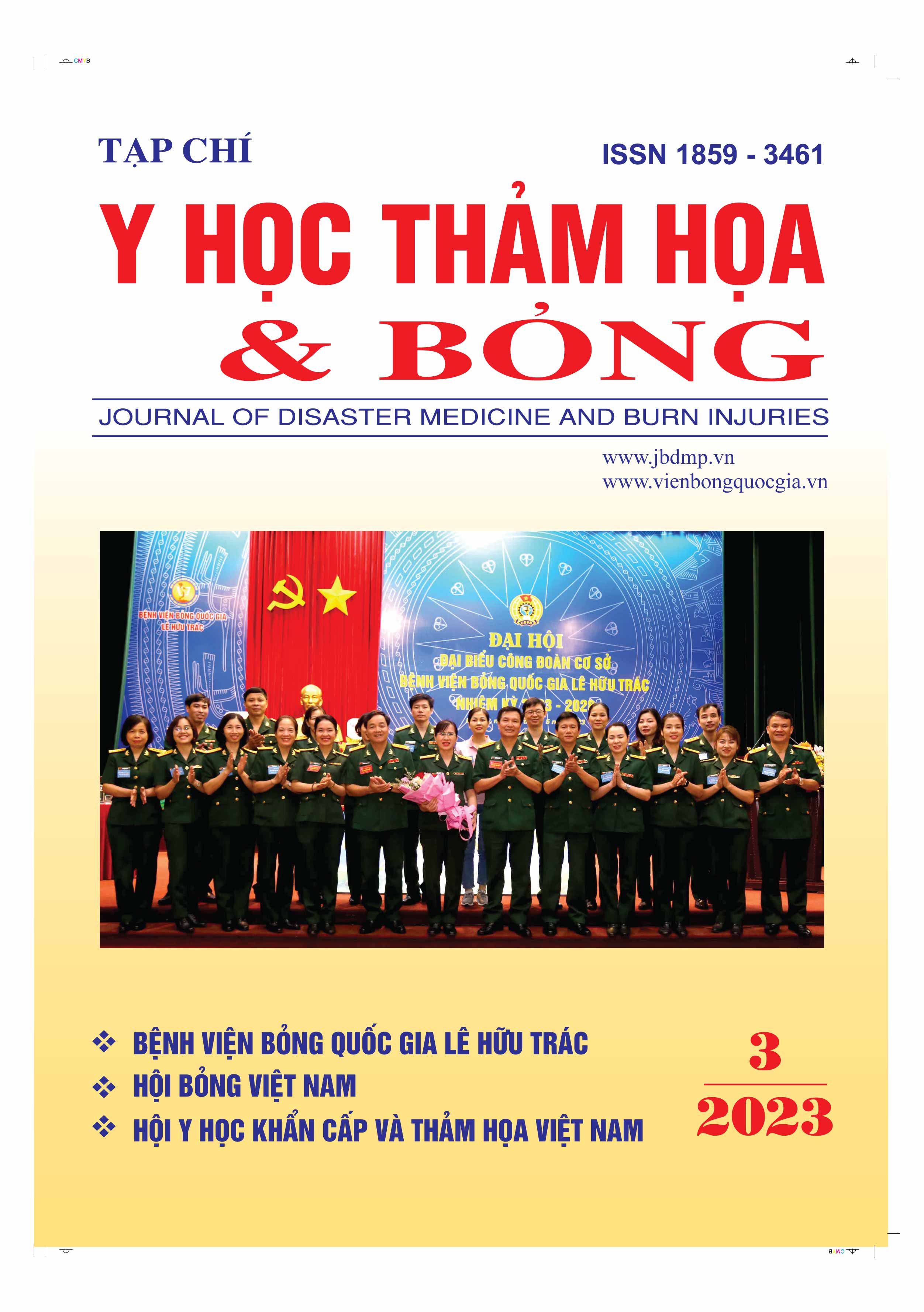Study on immunohistochemical and tissue ultrastructural changes at the experimental wound site after low-power laser irradiation
Main Article Content
Abstract
Objective: Evaluation of immunohistochemical morphological characteristics and tissue ultrastructural at the experimental wound site after low-power laser irradiation (780nm, dose 3J/cm2).
Subjects and methods: Prospective study on 30 rabbits, each rabbit created two full thickness 2R = 4cm wounds on both sides of the back: Wound A (treated with LLLT, 780nm, 3 J/cm2 with 72s irradiation time, 1 time per day); Wound B (control: no laser). Wounds are bandaged and laser irradiated once a day according to the procedure until the lesion is completely epithelialized. Wound biopsies were taken: Before treatment (D0), after 7 days (D7), and after 14 days (D14) of treatment.
Results: Immunohistochemical images at D7, D14 showed that the low-level laser therapy area appeared more vascular endothelial cells (+) with CD34 and more fibroblasts, vascular smooth muscle cells (+) SMA when compared to the control side. On the transmitted ultrastructural image (TEM) at D7, the low-level laser therapy area showed less tissue damage than the control side and there was tissue regeneration. Up to D14, the tissue regeneration rate in the low-level laser therapy area is stronger than in the non-irradiated area, increasing the activity of fibroblast organelles (mitochondrial, granular endoplasmic reticulum) and increasing collagen secretion into the extracellular matrix.
Conclusions: Low-level laser therapy (780nm, dose 3 J/cm2) accelerates the wound healing process in experimental rabbit models, stimulates vascular proliferation, and increases collagen synthesis in fibroblasts.
Article Details
Keywords
Low-level laser therapy, immunohistochemistry
References
2. Huang Y.-Y., Chen A.C.-H., Carroll J.D., et al. (2009). Biphasic dose response in low-level light therapy. Dose-response. 7(4): 358-383.
3. Đinh Văn Hân, Nguyễn Mạnh Hùng, Ngô Ngọc Hà (2014). Đánh giá ảnh hưởng của Laser bán dẫn vùng ánh sáng đỏ (630-670nm) tới quá trình liền vết thương cấp tính và mạn tính. Tạp chí Y học Thảm hoạ và Bỏng, số 5-2014: tr 160-169.
4. Chaves M.E.d.A., Araújo A.R.d., Piancastelli A.C.C., et al. (2014). Effects of low-power light therapy on wound healing: LASER x LED. Anais brasileiros de dermatologia. 89: 616-623.
5. AlGhamdi K.M., Kumar A., Moussa N.A. (2012). Low-level laser therapy: a useful technique for enhancing the proliferation of various cultured cells. Lasers in medical science. 27(1): 237-249.
6. Masson‐Meyers D.S., Andrade T.A., Caetano G.F., et al. (2020). Experimental models and methods for cutaneous wound healing assessment. International journal of experimental pathology. 101(1-2): 21-37.
7. Childs D.R., Murthy A.S. (2017). Overview of wound healing and management. Surgical Clinics. 97(1): 189-207.
8. Gushiken L.F.S., Beserra F.P., Bastos J.K., et al. (2021). Cutaneous wound healing: An update from physiopathology to current therapies. Life. 11(7): 665.
9. Tottoli E.M., Dorati R., Genta I., et al. (2020). Skin wound healing process and new emerging technologies for skin wound care and regeneration. Pharmaceutics. 12(8): 735.
10. Rashidi S., Yadollahpour A., Mirzaiyan M. (2015). Low-level laser therapy for the treatment of chronic wound: Clinical considerations. Biomedical and Pharmacology Journal. 8(2): 1121-1127.
11. Fortuna T., Gonzalez A.C., Sá M.F., et al. (2018). Effect of 670 nm laser photobiomodulation on vascular density and fibroplasia in late stages of tissue repair. International wound journal. 15(2): 274-282.
12. Hussein A.J., Alfars A.A., Falih M.A., et al. (2011). Effects of a low-level laser on the acceleration of wound healing in rabbits. North American journal of medical sciences. 3(4): 193-197.
13. Demidova‐Rice T.N., Salomatina E.V., Yaroslavsky A.N., et al. (2007). Low‐level light stimulates excisional wound healing in mice. Lasers Surg Med. 39(9): 706-715.


